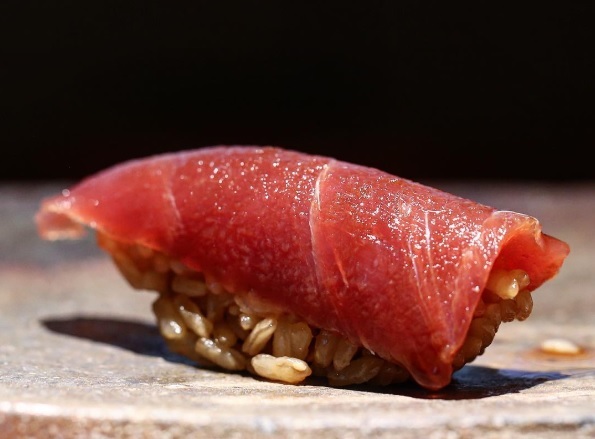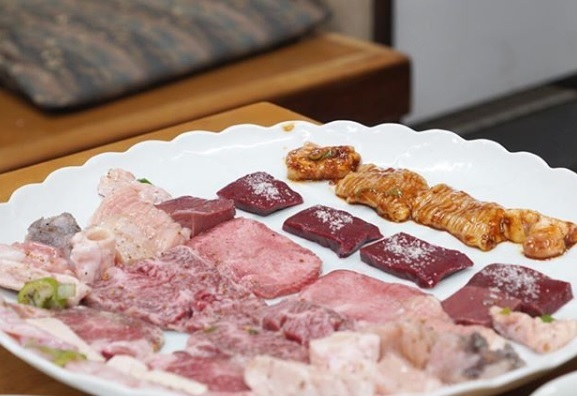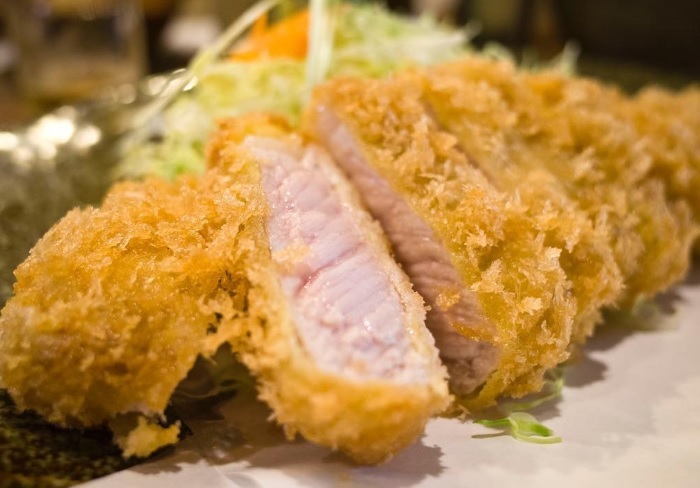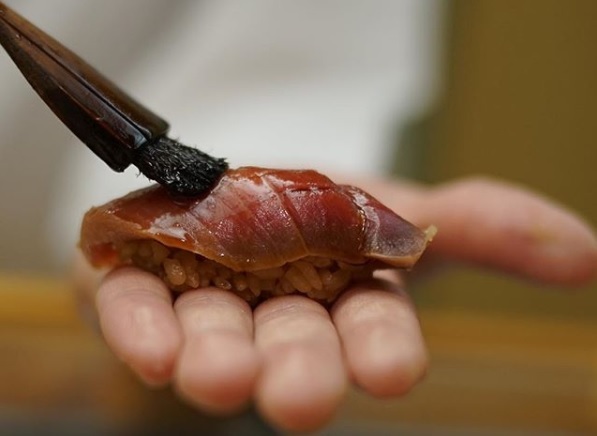30 Japanese Foods to Try While You Are in Japan
This article will introduce Japanese foods that you should try at least once when visiting Japan, one of the leading gourmet countries, for you, the foodies around the world who come to Japan to enjoy the food.
The options range from street food that costs just a few hundred yen to luxurious gourmet options costing in the tens of thousands of yen.
Before your visit, learn all about the delightful gourmet options that await you!
1. Sushi
Sushi, which is seasonal fish pressed onto rice seasoned with vinegar, salt, and sugar, is Japan's most popular food.
Particularly popular types of sushi include "toro," which is sliced fatty tuna, and "uni," sea urchin.
While sushi is available at restaurants like izakaya, you'll usually eat it at specialty sushi restaurants (called "sushi-ya").
The prices at sushi restaurants varies wildly, from 2,000 yen to over 30,000 yen, depending on the quality of the fish used.
If you want to keep your budget on the lower side, we recommend eating at a sushi chain restaurant around areas like Shibuya, Shinjuku, or Roppongi.
If you're a foodie who wants to experience authentic Edo-mae sushi without breaking the bank, the best way to do so is to have lunch at a luxury sushi restaurant in Ginza (at lunchtime you can enjoy some of the world's best sushi for just 10,000 yen).
★Recommended Sushi Restaurant
Sushi Suzuki
Address: 5F 6-5-15 Ginza, Chuo-ku, Tokyo
Phone: 03-5537-6868
Hours:
[Lunch] 12:00-14:00
[Dinner] 18:00-22:00
Budget: 10,000-14,999 yen (lunch)
Closed: Mondays
Credit cards not accepted
2. Tempura
Tempura is a dish made with items like seafood and vegetables that are dipped in a flour-based dredge then fried.
It's one of Japan's most well-known foods around the world along with sushi.
While it's a common food that you can find it at retail shops like supermarkets or in many restaurants like standing soba restaurants, specialty tempura restaurants make amazing tempura without holding back on ingredients needed or effort put in.
The traditional way to make tempura involves frying in sesame oil, but in more recent years some chefs have switched to safflower oil for its lighter aroma.
Classic tempura ingredients include shrimp, anago (conger eel), sillago, and bigeye flathead.
★Recommended Tempura Restaurant
Nihonbashi Sonoji
Address: 2-22-11 Nihonbashi Ningyocho, Chuo-ku, Tokyo
Phone: 03-5643-1566
Hours:
[Lunch] 12:00-14:00
[Dinner] 18:00-21:00
Budget: 10,000-14,999 yen (dinner)
Closed: Every Monday, 2nd and 3rd Sundays of the month
Credit cards accepted (VISA)
3. Ramen
Ramen is now the most popular noodle-based dish in the world, made by adding boiled Chinese noodles to a soup made with chicken or pork stock.
It was originally a dish made in China, but it continued to evolve and be developed in Japan.
The standard 3 soup bases used are shio (salt), shoyu (soy sauce), and miso, but in recent years chicken and tonkotsu (pork bone) broths have become quite popular.
Recently "shoyu chintan" ramen, which combines a chicken-based broth with shoyu, has become popular in Tokyo.
While ramen is technically part of the "street-food" genre and can be found for around 1,000 yen per bowl, in recent years some ramen restaurants like "Japanese Soba Noodle Tsuta" and "Nakiryu" have earned Michelin stars.
★Recommended Ramen Restaurant
Homemade Ramen Muginae
Address: 6-11-10 Minamioi, Shinagawa-ku, Tokyo
Hours:
[Lunch] 11:30-14:30
[Dinner] 18:00~
Budget: ~999 yen
Closed: Irregular holidays
Credit cards not accepted
4. Tonkatsu
Tonkatsu is a popular dish with the masses made by frying coated pork in lard.
It originated from the European dish "cutlet."
Many specialty restaurants offer two variations on tonkatsu: "hire," or fillet, for those who want to enjoy tender lean meat, and "rosu," or pork loin, which is juicy and contains more fat. Both varieties are usually offered as a "set menu" along with a side of shredded cabbage, miso soup, and rice.
While the tonkatsu may vary depending on the quality of pork used, most restaurants offer the above-mentioned tonkatsu set for around 1,000 yen.
Tonkatsu has become a super popular dish for foreigners in recent years, and long lines of tourists looking for a meal form outside of popular Tokyo restaurants like "Narikura" and "Tonta" before they even open.
★Recommended Tonkatsu Restaurant
Nomotoya
Address: 2F 2-3-7 Shibakoen, Minato-ku, Tokyo
Phone: 03-6809-1529
Hours:
[Lunch] 11:30-14:30
[Dinner] 17:30-20:30
Budget: 2,000-2,999 yen
Closed: Sundays, holidays
Credit cards not accepted
5. Yakiniku
Yakiniku is a refined dish on par with the likes of sushi.
It's a simple dish, made by grilling beef on an iron plate and dipping it in a soy sauce-based tare sauce before eating. Yakiniku originated on the Korean peninsula, but it continued to evolve and be developed in Japan.
The pieces of beef served at yakiniku restaurants can be divided into two groups: "meats," which include cuts like fillet, chuck, and sirloin, and "motsu (internal organs)." The standard order is to start with cuts of meat, then follow up with motsu.
While yakiniku is a high-class dish, it's priced cheaper than sushi, and you can fill up at luxury yakiniku restaurants that serve wagyu beef for around 10,000 yen.
★Recommended Yakiniku Restaurant
Daikanyama Yakiniku Kaneko
Address: 17-17 Sarugacho, Shibuya-ku, Tokyo
Phone: 03-6415-4129
Hours: 18:00-24:00
Budget: 10,000-14,999 yen
Closed: Sundays
Credit cards not accepted
6. Yakitori
Yakitori, which is different parts of the chicken skewered and grilled over fire, is a dish unique to Japan.
The best yakitori is grilled over a charcoal fire, not over a gas flame.
No matter which yakitori restaurant you visit, you'll likely encounter just two options for seasoning: "shio (a simple seasoning of just salt)" and "tare (where the chicken is dipped into a soy-sauce-based tare sauce then cooked)." Orders are typically placed by requesting both the part and seasoning together (for example, "liver, seasoned with shio.").
Popular pieces to order include "sasami (chicken breast)," liver, heart, and "tsukune (minced chicken meat blended with egg and starch, then shaped into balls and grilled)."
Yakitori is one of the most popular dishes for the masses, and your bill is likely to come out to 5,000-8,000 yen at any restaurant specializing in yakitori.
★Recommended Yakitori Restaurant
Torie Ueno Hirokoji
Address: 3-40-8 Yushima, Bunkyo-ku, Tokyo
Phone: 03-3836-0211
Hours: 17:30-23:00
Budget: 8,000-9,999 yen
Closed: Sundays
Credit cards accepted (VISA, MASTER, JCB, AMEX)
7. Yakiton
Yakiton is the pork version of yakitori.
It's typically made using pork organs, and some restaurants offer "miso" as seasoning in addition to "shio" and "tare."
The yakiton you can find at specialty restaurants is extraordinarily cheap, and you can typically have a full meal at around half the price of yakitori (2,000-3,000 yen).
The usual way to enjoy yakiton is while having a good time with friends and drinking beer or sake.
★Recommended Yakiton Restaurant
Akimotoya
Address: 5-28-3 Nogata, Nakano-ku, Tokyo
Phone: 03-3338-6236
Hours: 17:00-24:00
Budget: 2,000-2,999 yen
Closed: Mondays
Credit cards not accepted
8. Parfaits
Parfaits are a colorful dessert made by packing cold treats like ice cream, jelly, and pudding into a tall glass with fresh cream and fruit.
They have their origins in French desserts that involve ice-cream-like frozen treats that are topped with sauces and chilled fruit, but Japan has developed its own unique version.
In more recent years, the beautifully artistic parfaits made by talented patissiers have been uploaded to women's Instagram pages in droves.
Depending on the region, there are many variations on parfaits, including "natto parfaits," "tonkatsu parfaits," and "kimchi parfaits."
Parfaits are a common dessert at cafes and coffee shops, and you can typically find them in the price range of 1,000-2,000 yen.
★Recommended Parfait Shop
PATISSERIE ASAKO IWAYANAGI
Address: 4-4-5 Todoroki, Setagaya-ku, Tokyo
Phone: 03-6432-3878
Hours: 10:00-19:00
Budget: 2,000-2,999 yen
Closed: Mondays
Credit cards accepted (VISA, MASTER, JCB, AMEX, Diners)
9. Pancakes
Pancakes are a classic American food made from flour, eggs, and milk, but in recent years they've seen an explosive increase in popularity in Japan, which has led to unique developments of the dish.
The so-called "Japanese pancake" is made with ingredients like cheese, meringue, or yogurt, and they're characterized by a "bouncy" and "fluffy" texture. Popular ways to enjoy your pancake are with whipped butter or manuka honey.
Popular pancake shops like "Shiawase no Pancake" and "Chaka" tend to build up long queues of waiting women even before opening.
★Recommended Pancake Shop
Shiawase no Pancake Omotesando Store
Address: B1F 4-9-3 Jingumae, Shibuya-ku, Tokyo
Phone: 03-3746-8888
Hours: 9:30-19:30
Budget: 1,000-1,999 yen
Closed: Irregular holidays
Credit cards accepted (VISA, MASTER, JCB, AMEX, Diners)
http://magia.tokyo/menu
10. Okonomiyaki
Okonomiyaki is a food that's original to Japan, made by grilling flour-and-water batter, chopped cabbage, seafood, and meat on an iron hotplate.
The two major styles of okonomiyaki are "Osaka-style," in which the batter and fillings are mixed together before cooking, and "Hiroshima-style," in which the fillings are piled on top of the batter then cooked, and preferences between the two vary person to person.
Hiroshima-style okonomiyaki is also characterized by its inclusion of udon or soba noodles.
In the past, the mainstream style of serving okonomiyaki involved customers cooking their own portions on teppan grills built into the tables, but many modern restaurants have their staff skillfully prepare the okonomiyaki for the customers instead.
No matter where you go, okonomiyaki tends to run about 1,000 yen, and you typically can have a good time eating it with friends while having a beer or some sake.
★Recommended Okonomiyaki Restaurant
Okonomiyaki Kiji Shinagawa
Address: Shinagawa Front Building 2F, 2-3-13 Konan, Minato-ku, Tokyo
Phone: 03-6712-0256
Hours:
[Lunch] 11:00-15:30
[Dinner] 17:00-23:00
Budget: 2,000-2,999 yen
Closed: Irregular holidays
Credit cards accepted (VISA, MASTER, JCB, AMEX, Diners)
11. Yakisoba
Yakisoba is a dish made with steamed (or boiled) Chinese noodles that are then stir-fried with meat like pork, and vegetables like cabbage, carrots, onions, and bean sprouts.
It can be seasoned with different things like Worcester sauce, soy sauce, salt, pepper, oyster sauce, and ketchup.
Until recently yakisoba was a minor force on the street food scene, eclipsed by the likes of ramen and udon, but in recent years there has been an increase in the number of yakisoba specialty restaurants around, making a small boom on the streets.
Other than at specialty restaurants, you can also order yakisoba at okonomiyaki restaurants.
Yakisoba runs about 800-1,000 yen per person.
★Recommended Yakisoba Restaurant
Teppanya Shuu
Address: 3-14-4 Shibuya, Shibuya-ku, Tokyo
Phone: 03-6427-9964
Hours:
[Lunch] 11:30-15:00
[Dinner] 17:30-22:00
Budget: ~999 yen
Closed: Irregular holidays
Credit cards not accepted
12. Soba
Soba is a Japanese noodle dish made with buckwheat flour, processed from the grain of buckwheat.
It is enjoyed for the faint aroma of buckwheat when you eat it and the feel of the noodles as they slide down your throat.
Soba is eaten by taking the noodles, made with a blend of buckwheat flour and wheat flour, and dipping them into a broth made with dashi from bonito flakes and kombu kelp as well as soy sauce, then slurping them down.
It's a particularly popular meal for busy businessmen, since it's a cheap dish that you can finish quickly.
Popular toppings for soba include shrimp and anago tempura.
Some luxury soba restaurants, like "Tamawarai" in Tokyo, have obtained Michelin stars, but most local people tend to eat at standing soba restaurants in places like stations.
You can enjoy soba from morning onward for just 300-500 yen.
★Recommended Soba Restaurants
Sobakiri Sake Taigu
Address: 1-19-10 Nishi Shinbashi, Minato-ku, Tokyo
Phone: 03-3597-0359
Hours: 18:00-22:30
Budget: 6,000-7,999 yen
Closed: Sundays, holidays, 1st Saturday of the month
Credit cards not accepted
13. Udon
Udon is a Japan-original noodle dish, made by cutting a dough made of flour and saline water into long noodles.
The noodles have a faint wheat aroma to them and are delightfully chewy, making them incredibly popular among young people, just like ramen.
Standing soba restaurants, like those located in subway stations, often serve udon too, but we recommend visiting an udon specialty restaurant if you want to have some truly delicious udon.
Two of the most popular ways to enjoy udon are as "kake-udon (topped with your preferred items, like tempura)," which involves chewy noodles served with an elegant broth made from bonito flakes and kombu kelp, and "kamatama," where freshly-boiled noodles are mixed with raw egg and topped with butter.
★Recommended Udon Restaurant
Udon Maruka
Address: 3-16-1 Kanda Ogawamachi, Chiyoda-ku, Tokyo
Phone: 03-3597-0359
Hours: 11:00-19:30 (until 14:30 on Saturdays)
Budget: ~999 yen
Closed: Sundays, holidays
Credit cards not accepted
14. Curry Rice
Curry rice is an Indian dish that reached Japan through England, and it has become a popular Japanese food that can rival ramen.
Popular styles of curry include the original "Indian curry," which is made with onion and a variety of spices, "European curry,"made with flour, demi-glace sauce, and butter, and "Thai curry," made with coconut milk and lemongrass.
The most well-known curry restaurant is the chain "CoCo Ichibanya," which serves its own unique take on European-style curry and has over 1,200 locations across Japan.
Recently there have been more and more curry specialty restaurants cropping up that are run by fanatic owners who make unique styles of curry that do not fit into the existing genres, and some tourists visiting Japan even make a point to only visit curry restaurants during their trip.
★Recommended Curry Shop
Yoshida Curry
Address: 2F 3-8-2 Amanuma, Suginami-ku, Tokyo
Hours:
[Lunch] 11:30-13:50
[Dinner] 17:30-20:00
Budget: 1,000-1,999 yen
Closed: Wednesdays, Thursdays, Sundays, holidays
Credit cards not accepted
15. Sukiyaki
Sukiyaki is a hotpot meal unique to Japan in which thinly-sliced beef is simmered in a shallow iron pot.
It is characterized by its well-balanced sweet and salty flavors thanks to the use of sugar and soy sauce.
Sukiyaki can be divided into two major styles: "Kanto style," in which you combine soy sauce, sake, sugar, and mirin into a seasoned broth before adding meat and vegetables to cook, and "Kansai style," where you add seasonings to meat and vegetables that have been grilled on an iron plate. In recent years, more and more restaurants that follow the Kansai style of sukiyaki have cropped up, claiming that "you can enjoy the flavors of the meat more."
The "correct way" to eat the meat in sukiyaki is alongside beaten raw egg, but there are many foodies who enjoy their sukiyaki without the egg so that the flavor of the meat isn't detracted from.
Sukiyaki from a specialty restaurant that uses luxurious wagyu beef costs around 10,000-15,000 yen.
★Recommended Sukiyaki Restaurant
Imafuku
Address: 1-12-19 Shirokane, Minato-ku, Tokyo
Phone: 050-2018-0982
Hours: 17:00-24:00
Budget: 10,000-14,999 yen
Closed: Never
Credit cards accepted (VISA, MASTER, JCB, AMEX, Diners)
16. Shabu Shabu
Shabu shabu is a Japanese hotpot dish in which thinly sliced beef or pork and vegetables are cooked by dipping into hot broth in a special pot, then dipped in tare sauce before being eaten.
Shabu shabu specialty restaurants tend to offer two types of tare, which are ponzu and sesame tare, and customers are able to choose between them according to their preferences.
It used to be that shabu shabu was assumed to use wagyu beef, but in recent years pork shabu shabu, which can be more refreshing to eat, has gained popularity.
It's typical to add things like rice, udon noodles, and ramen noodles into the remaining broth after eating all of the other ingredients and enjoy it as soup.
There aren't many so-called shabu shabu specialty restaurants, but many sukiyaki restaurants offer shabu shabu as well.
The cost of wagyu beef shabu shabu at a specialty restaurant is around 10,000-15,000 yen.
★Recommended Shabu Shabu Restaurant
Tokyo Niku Shabuya
Address: 1-12-3 Okubo, Shinjuku-ku, Tokyo
Phone: 050-5592-1529
Hours:
[Lunch] 12:00-14:30 (Saturdays only)
[Dinner] 17:00-23:00
Budget: 10,000-14,999 yen
Closed: Irregular holidays
Credit cards accepted (VISA, MASTER, JCB, AMEX, Diners)
17. Beef Tongue Set
Beef tongue is a popular choice for set meals, made with thick-sliced beef tongue that's grilled and served with boiled barley and rice and oxtail soup.
The characteristic crunchy texture of beef tongue is irresistibly good, and once lunchtime rolls around there's invariably a long line of businessmen waiting outside of specialty restaurants.
As you can only get about 1-2kg of tongue from each cattle, the cost of a beef tongue set meal is a bit higher than other options, costing around 1,500-2,000 yen for the set.
★Recommended Beef Tongue Restaurant
Negishi Dogenzaka Store
Address: B1F 2-29-8 Dogenzaka, Shibuya-ku, Tokyo
Phone: 03-3770-0227
Hours: 11:00-23:00
Budget: 1,000-1,999 yen
Closed: Never
Credit cards accepted (VISA, MASTER, JCB, AMEX, Diners)
18. Motsunabe
Motsunabe is a classic winter Japanese hotpot dish, made by simmering beef offal with tofu, leeks, and cabbage.
As it's cooked in a pot, fattier pieces like the large and small intestines are the preferred cuts to use.
Most motsunabe specialty restaurants offer three types of soup: shoyu, shio, and miso. Customers are able to choose their preferred soup from these options.
Traditionally in the Kyushu region, where motsunabe originated, once you've finished eating the main ingredients you add thick noodles into the soup to finish it all off.
Since motsunabe is a dish that uses relatively inexpensive offal, it will come out to around 4,000-5,000 yen per person at any specialty restaurant you go to.
★Recommended Motsunabe Restaurant
Hakata Motsunabe Aritsuki Ebisu
Address: 2-9-5 Ebisu, Shibuya-ku, Tokyo
Phone: 03-5424-0656
Hours: 18:00-24:00
Budget: 4,000-4,999 yen
Closed: Irregular holidays
Credit cards accepted (VISA, MASTER, JCB, AMEX, Diners)
19. Unaju
Unaju is a premium donburi (rice bowl) dish, made by topping white rice with aromatic grilled unagi (eel).
The best unagi is always grilled over a charcoal fire rather than over a gas flame.
There are two major styles of preparing the unagi: "Kanto style," in which the trimmed eel is steamed before being grilled, and "Kansai style," where the eel is grilled without steaming.
Kanto style unagi is known for its melt-in-your-mouth texture, while Kansai style unagi is firmer and has a crispy texture and rich aroma.
Nagoya is home to its own unique but popular way to eat unagi, known as "hitsumabushii," where Kansai style unadon is topped with green onion, ginger, and dashi broth then eaten.
As freshwater eel becomes more and more scarce its price continues to rise, and one person's portion currently costs around 3,000-5,000 yen.
Specialty restaurants that use even more rare natural wild eels (most restaurants use farmed eels) can charge over 10,000 yen for one bowl of unadon.
★Recommended Unagi Restaurant
Unagi Uomasa
Address: 4-14-4 Yotsugi, Katsushika-ku, Tokyo
Phone: 03-3695-5222
Hours:
[Lunch] 11:30-14:00
[Dinner] 17:00-21:00
Budget: 10,000-14,999 yen
Closed: Every Tuesday, 1st and 3rd Wednesdays of every month
Credit cards accepted (VISA, MASTER, JCB, AMEX, Diners)
20. Fugu
Fugu is an ultra-luxurious dish that is best eaten during the winter (November through March).
The best fugu is considered to be made with the Japanese pufferfish found in the western part of the Sea of Japan.
The most common way to enjoy fugu is as part of an "omakase" (chef's choice) course at a fugu specialty restaurant that is licensed to prepare it, and the course is likely to include things like fugu sashimi (thinly sliced fugu with ponzu sauce), fried fugu, grilled fugu milt, fugu hotpot, and rice added to the remaining soup from the hotpot.
Specialty restaurants that prepare rare wild Japanese pufferfish are expensive, and you should expect to pay 30,000-50,000 yen per person.
★Recommended Fugu Restaurant
Ajiman
Address: 3-8-8 Roppongi, Minato-ku, Tokyo
Phone: 03-3408-2910
Hours: 18:00-24:00
Budget: 30,000-49,999 yen
Closed: Never (Open September through March)
Credit cards not accepted
21. Oden
Oden is a dish that involves taking broth seasoned with bonito flakes and kombu kelp, adding to it a variety of ingredients like satsuma-age, hanpen, grilled chikuwa, tsumire, konnyaku, daikon radish, ganmodoki, chikuwa, beef tendon, boiled egg, and fried tofu, and then simmering for an extended period of time.
While the lineup of ingredients used in oden is going to be similar wherever you are in Japan, the seasoning of the soup stock used varies from region to region. (A very light broth is used in Osaka and Kyoto, a very rich broth is used in Nagoya, and a somewhat strongly flavored broth is used in the areas around Tokyo.)
There are oden specialty shops scattered about in major cities, but most locals are more familiar with convenience store oden at places like 7-Eleven.
The ingredients used in oden are expensive, so each piece is around 300-500 yen.
Oden is a winter treat commonly enjoyed with hot sake.
★Recommended Oden Shop
Kushikomabo
Address: 1-33-27 Kitaotsuka, Toshima-ku, Tokyo
Phone: 03-3916-0355
Hours: 18:00-24:00
Budget: 6,000-7,999 yen
Closed: Sundays
Credit cards accepted (JCB, AMEX, Diners)
22. Yoshoku (Western-Style Food)
Yoshoku is an umbrella term for western-style food, inspired by western European food, that is seasoned with things like demi-glace sauce and ketchup.
Yoshoku in Japan has become a widespread category of food that rivals the likes of ramen, udon, and tonkatsu, and there are many yoshoku specialty restaurants, called yoshoku-ya, in major cities.
Typical dishes in the yoshoku genre include hamburger steak, omurice (rice mixed with ketchup that is then wrapped in half-cooked egg), and fried dishes (foods like pork, shrimp, and scallops fried aromatically in lard).
Some yoshoku restaurants, like "Toyoken" and "Restaurant Kamiya," have prices that can come to over 10,000 yen per person, but most local yoshoku-ya that you'll find in the alleyways of sightseeing areas will have plenty of options for 1,000-2,000 yen per person.
★Recommended Yoshoku Restaurant
Azabu Shokudo
Address: 4-18-1 Nishiazabu, Minato-ku, Tokyo
Phone: 03-3409-4767
Hours:
[Lunch] 11:30-14:00
[Dinner] 17:30-21:30
Budget: 1,000-1,999 yen
Closed: Sundays, Mondays, holidays
Credit cards accepted (VISA, MASTER, JCB, AMEX, Diners)
23. Gyudon
Gyudon is a donburi (rice bowl) dish, made by topping rice with thinly-sliced beef that has been simmered in soy sauce and sugar, and it is a popular dish around the world.
Thanks to being a "cheap, quick, and tasty" donburi dish, gyudon is incredibly popular among busy businessmen.
Common ways to eat gyudon are with scrambled raw egg or shichimi togarashi pepper on top.
Yoshinoya is home to around 1,200 gyudon restaurants, so densely packed that there's a saying in Japan that "gyudon is synonymous with Yoshinoya."
Gyudon is a Japanese food that sates the hunger of busy workers at every corner across Japan.
★Recommended Gyudon Restaurant
Yoshinoya Tsukiji Store #1
Address: 5-2-1 Tsukiji, Chuo-ku, Tokyo
Phone: 03-5550-8504
Hours: 5:00-13:00
Budget: ~999 yen
Closed: Sundays, holidays, when Tsukiji Market is closed
Credit cards not accepted
24. Oyakodon
Oyakodon is a donburi dish made by simmering chicken breast in a broth made with bonito flakes and kombu kelp, mixing it with beaten egg, and serving over rice.
The "oyako" in the name, which means "parent and child," comes from the use of both chicken and egg in the dish.
A recent trend with oyakodon is to half-cook the eggs, then mix them in with the rice before eating.
Restaurants that specialize in oyakodon are fairly rare, and it's common to have oyakodon at soba restaurants in Japan.
★Recommended Oyakodon Restaurant
Taizen
Address: 1-23-11 Shinjuku, Shinjuku-ku, Tokyo
Phone: 03-6380-5228
Hours: 11:30-14:00 (Open only on Mondays, Thursdays, and Fridays)
Budget: 1,000-1,999 yen
Closed: Sundays
Credit cards not accepted
25. Takoyaki
Takoyaki is a type of street food that originated in Osaka, and they are made by baking a flour-based dough filled with octopus and green onion into a 3-5cm ball.
Takoyaki are commonly eaten topped with a special sauce, mayonnaise, and aonori.
In recent years people have created many different versions of takoyaki, packed with either melty or crispy fillings.
A serving of 8 pieces of takoyaki for one person tends to cost around 400-500 yen.
The inside of takoyaki is very hot, so be careful of the temperature when eating it all in one bite!
★Recommended Takoyaki Shop
Tsukiji Gindaco Highball Sakaba Shibuya Higashiguchi Store
Address: 2-22-13 Shibuya, Shibuya-ku, Tokyo
Phone: 03-6418-5065
Hours: 11:00-23:00
Budget: ~999 yen
Closed: Never
26. Jingisukan
Jingisukan is a variation on yakiniku that is made with mutton (sheep meat) and lamb (young sheep).
Thinly sliced mutton and vegetables are grilled on a convex jingisukan plate, and the juices from the mutton are absorbed into the cooking vegetables.
Varieties of the meat used include "seasoned meat" that has been marinated, "raw meat" that has been chilled, and "roll meat" that has been frozen.
As jingisukan is a dish where you can enjoy the wild, meaty flavor of mutton but is still low in calories, it's actually very popular with young women who are watching their figure.
You will usually find jingisukan at specialty restaurants, and it runs about 3,000-5,000 yen per person.
★Recommended Jingisukan Restaurant
Kin no Hitsuji
Address: 4-15-4 Shinbashi, Minato-ku, Tokyo
Phone: 03-3432-8929
Hours: 17:00-24:00
Budget: 4,000-4,999 yen
Closed: Sundays
Credit cards not accepted
27. Kushikatsu
Kushikatsu is a cheap and delicious food from Osaka, in which meat and vegetables are skewered, battered, and fried.
The so-called "New World" neighborhood near Tsutenkaku, a popular sightseeing spot, is packed with kushikatsu shops, and many tourists who visit Osaka came with the goal of "eating kushikatsu in the New World."
Kushikatsu shops like "Kushikatsu Tanaka" have gained traction in Tokyo in recent years too thanks to their cheap prices and junk-food taste.
Eating your fill at a kushikatsu specialty shop will typically run you at most 2,000 yen per person.
★Recommended Kushikatsu Shop
Kushikatsu Tanaka Shibuya Sakuragaoka Store
Address: 2F 4-2 Sakuragaokacho, Shibuya-ku, Tokyo
Phone: 050-5872-4022
Hours: 17:00-2:00am the following day
Budget: 2,000-2,999 yen
Closed: Never
Credit cards not accepted
28. Kakigori
Kakigori is the Japanese version of shaved ice, a frozen dessert made with extremely fine shaved ice that is topped with flavored syrup.
In Japan it was typical to enjoy strawberry and melon-flavored kakigori during the summer or at the beach, but recent years have seen kakigori specialty shops around cities that are open year-round.
Kakigori fans are enchanted by the creative sauces, made with seasonal fruits, that the eccentric shop-owners have come up with.
"Jigen," which is the highest-rated kakigori shop on Tabelog, is so popular that no matter the season it always has a 1-hour-long wait, despite being located around 2 hours outside of Tokyo.
★Recommended Kakigori Shop
Shimura
Address: 3-13-3 Mejiro, Toshima-ku, Tokyo
Phone: 03-3953-3388
Hours: 10:00-19:00
Budget: 1,000-1,999 yen
Closed: Sundays
Credit cards not accepted
29. Kamameshi
Kamameshi is a single-pot rice dish, where ingredients like meat and seafood are placed on top of rice seasoned with soy sauce and mirin and all cooked together in an iron pot.
Popular varieties include "chicken kamameshi," a simple version topped with minced chicken and soy sauce, "gomoku (mix of five) kamameshi," made with the five ingredients of chicken, lotus root, fried tofu, shiitake mushroom, and carrot, and "oyster kamameshi," which is usually made in the winter with plump in-season oysters.
As kamameshi requires specialized cookware to make, it's typically eaten only at specialty restaurants.
It tends to cost around 1,000-2,000 yen per person.
★Recommended Kamameshi Restaurant
Kamameshi Mutsumi
Address: 3-32-4 Asakusa, Taito-ku, Tokyo
Phone: 03-3874-0600
Hours: 11:30-21:30
Budget: 3,000-3,999 yen
Closed: Wednesdays, every other Tuesday
Credit cards not accepted
30. Dorayaki
Dorayaki is a Japanese sweet made by sandwiching fillings like red bean paste between two fluffy castella-like pancakes.
It has become well-known worldwide as the treat loved by the popular Japanese anime character Doraemon.
Red bean paste made from adzuki beans used to be the only filling used in dorayaki, but recently different varieties of dorayaki filled with things like cream cheese, chocolate, and butter have become popular, particularly among younger people.
★Recommended Dorayaki Shop
Kamejuu
Address: 2-18-11 Kaminarimon, Taito-ku, Tokyo
Phone: 03-3841-2210
Hours: 10:00-20:30
Budget: ~999 yen
Closed: Irregular holidays
Credit cards not accepted
Register account first.
Register










Comments 2
2
Terence
I've never had Sukiyaki in Tokyo (I have had Shabu-shabu a few times and really like it).
Any recommendations for great Sukiyaki? I heard that at some restaurants the Sukiyaki is prepared for you? That sounds good since I'm always a little worried that I'm not cooking the meat right at Shabu-shabu or Yakiniku. :)
Kengo Yamada
Tokyo gourmet emperor/German cars for life/Dan beste, oder nichtsFor the tourists coming to Japan for the first time, we made an article that comprehensively introduces Japanese food that can be enjoyed at restaurants.